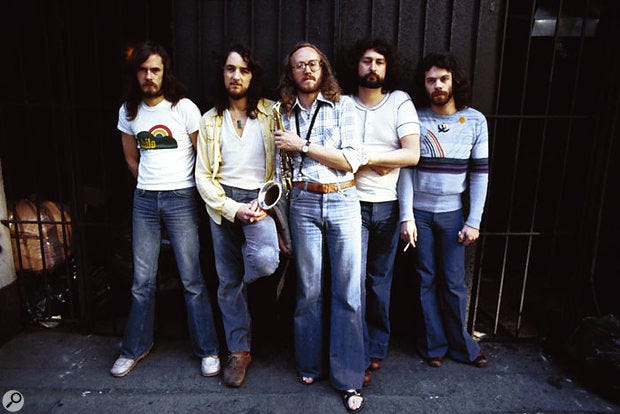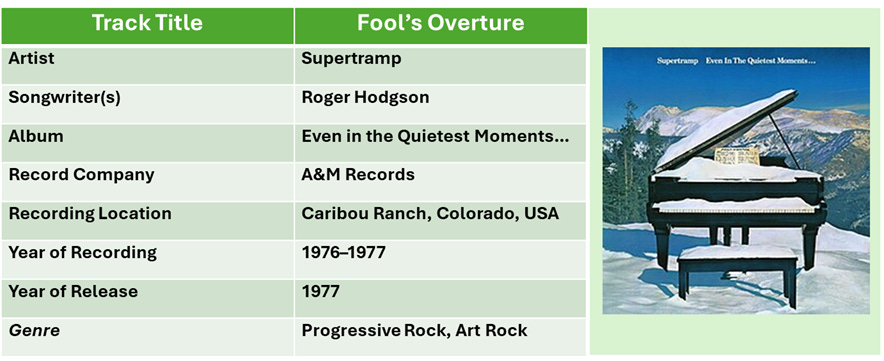
Well, some people fall in love with a band through their biggest hits. For a band like Supertramp, that could mean the breezy optimism of Dreamer or the razor-sharp wit of The Logical Song. I already knew and liked both great songs; they were part of the soundtrack of my life, but one day, sitting in my uncle’s living room, with his huge wooden stereo console and an LP spinning lazily, I heard something different from them.
Oh, the opening was strange… quiet… almost cinematic, and then, it bloomed into a 10-minute sonic journey that didn’t just play, it spoke. That track I’m talking about is Fool’s Overture, and from that day on, Supertramp wasn’t just that band with good songs. They became artists in my mind, bold enough to fuse rock, pop, jazz, orchestral flourishes, and prog into something utterly their own.
I walked into that room thinking Supertramp was fun, and I walked out knowing they were brilliant.
A First Encounter with the Overture
Overture isn’t just a fancy word in the title; this piece feels like a grand introduction, a prelude to something big, and yet, there’s no traditional verse-chorus structure here.
The song starts with soft ambient sounds: wind, a clock chime, and snippets of Winston Churchill’s famous WWII “we shall fight on the beaches” speech. You can almost see the grey skies and feel the weight of history.
Then, in true prog-rock fashion, the music swells; layers of keyboards, harmonicas, and saxophones interweave, painting this vast, cinematic scene. Rick Davies’s rich keys provide the backbone, while Roger Hodgson’s voice, that unmistakable, ethereal tenor, delivers lines that sound more like fragments of a dream than a straightforward story. It’s surreal, it’s emotional, and it’s sprawling.
And for a kid hearing it for the first time in a warm, dimly lit room full of old records, it was like opening a secret door into a much bigger world of music.
What’s Going on in This Song?
At its core, Fool’s Overture is about history, humanity, and the absurdity of repeating our mistakes. The Churchill speech isn’t just for drama; it frames the song as a reflection on conflict and resilience, but the lyrics are more cryptic, almost impressionistic.
Hodgson often described his writing style as “painting with words,” and here, the strokes are broad but vivid.
And yet, the instrumental sections are where the magic really happens; they’re not just bridges; they’re emotional landscapes. Davies’s keyboards swirl like clouds over a battlefield, and well, John Helliwell’s saxophone cuts through like sunlight after a storm, while Bob Siebenberg’s drumming drives the dynamics without ever being flashy.
By the time the final section comes around, with its soaring harmonies and slow fade, you feel like you’ve just watched a movie, one that shifts between a war documentary, an art film, and a freaking dream sequence.
The World in 1977: A Snapshot
So, to really understand Fool’s Overture, it might help to peek at the year it arrived, 1977, and what was going on.
Socially?
The late ’70s were a mix of uncertainty and rebellion. The Vietnam War had ended just two years before, but the Cold War was making sure to keep nuclear anxiety alive. Punk rock was exploding in the UK, thumbing its nose at the grandiosity of prog and arena rock, and disco was at its glittering peak, filling dance floors worldwide.
In music?
Prog rock was evolving; Pink Floyd was riding high after Wish You Were Here (1975) and gearing up for Animals (also 1977). Yes, and Genesis were still big names, but they were slowly trimming their 20-minute epics into more accessible forms, and Supertramp fit in a unique space, not quite as indulgent as full-on prog, but far too intricate for pop or traditional rock. Even in the Quietest Moments… proved they could balance depth with listenability.
In technology?
Personal computing was still in its infancy; the Apple II had just been released. The Atari 2600 brought video games into homes, and music gear was getting more sophisticated too; synthesizers were becoming more portable and polyphonic, allowing bands like Supertramp to layer sounds in ways unthinkable a decade earlier.
Why Fool’s Overture Was (and Is) Special
This track was a flex, not the “look at my guitar solo” type, but the “we can write a 10-minute song that’s part history lesson, part musical odyssey, and people will still buy the album” type. In 1977, that was bold, and in today’s skip-happy streaming era, it’s downright rebellious.
The beauty of Fool’s Overture is that it doesn’t try to be everything at once; it takes its time, it invites you in, and it demands you listen, not just hear. And the payoff doesn’t come as an instant dopamine hit but as long, slow swells of emotion that sneak up on you.
For me, it also shattered the neat little boxes I’d been keeping music in. Before that afternoon, songs were “fast” or “slow,” “sad” or “happy.” This one was everything: thoughtful, dramatic, nostalgic, and uplifting all at once.
The Supertramp Alchemy
Let’s give credit where it’s due; this was peak Supertramp. The Hodgson/Davies partnership was firing on all cylinders; Hodgson brought the ethereal melodies and introspective lyrics, while Davies grounded them with rich, bluesy chord progressions and rhythmic drive. Helliwell’s sax added that unmistakable Supertramp warmth, Thomson kept the low end melodic, and Siebenberg was the rhythmic glue that held the whole adventure together.
It’s easy to forget how technically demanding their music could be because it sounds so effortless. But Fool’s Overture is loaded with intricate arrangements, tempo changes, and tonal shifts that would be a nightmare for a lesser band to pull off live.
Band Lineup (for the recording):
Roger Hodgson, vocals, keyboards, guitar
Rick Davies, keyboards, backing vocals
John Helliwell, saxophone, clarinets, backing vocals
Dougie Thomson, bass guitar
Bob Siebenberg, drums, percussion
My Take: Then and Now
That first listen at my uncle’s house was a kind of awakening. I’d known Supertramp as a “hits” band; back in the day they were a bit on the radio, a reliable source of catchy radio tunes. But Fool’s Overture showed me they were also architects of big, daring, genre-defying music.
Today, every time I play it, I still feel the same pull. Maybe it’s nostalgia, but I think it’s more than that; there’s something timeless about the way it weaves history, melody, and atmosphere. The world has changed a lot since then, but the emotional core of this song still hits.
If you’ve never heard it, let me ask you, don’t just stream it in the background while you fold laundry or read the news. Give it the full treatment: lights low, good speakers or headphones, and volume up. Let it take you where it wants to go.
Geekatune Verdict:
If The Logical Song and Dreamer are Supertramp’s charming smile, Fool’s Overture is their soul. It’s the proof that they could stand shoulder-to-shoulder with the great prog acts of their era while keeping their own quirky, melodic identity.
And for me? It’s a track that made me fall in love with the idea that music is often much more than entertainment; it can be an experience.
So go ahead, step into the overture; you might just find yourself hearing Supertramp, and maybe music itself, in a whole new way.
Track Info
🎵 Listen to it here:
Spotify │ Apple Music │ Amazon Music
Bonus:
Yes, I love live versions. Check out the Fool's Overture live performance (Live in Paris '79)
Want to hear the chaos behind the posts?
🔊Check out Geekatune’s playlist on Spotify It’s got every track we’ve talked about on the blog. Eclectic? Absolutely. Predictable? Never.


